Themed collection Fundamental Processes in Optical Nanomaterials

Introduction to fundamental processes in optical nanomaterials
Alison Funston, Eva Hemmer, Arindam Chowdhury and Jon Veinot introduce this Nanoscale and ChemComm themed collection on fundamental processes in optical nanomaterials.

Nanoscale, 2024,16, 8193-8195
https://doi.org/10.1039/D4NR90078B
Colloidal quantum dot materials for next-generation near-infrared optoelectronics
Colloidal quantum dots (CQDs) are a promising class of materials for next-generation near-infrared optoelectronic devices, such as solar cells, lasers, photodetectors, and other applications.

Chem. Commun., 2024,60, 1072-1088
https://doi.org/10.1039/D3CC04315K
Aggregation-induced emissive nanoarchitectures for luminescent solar concentrators
Recent advances in aggregation-induced emitters for luminescent solar concentrators are discussed, focusing on molecular designs enabling operation in the deep-red/near-infrared regions, for prospective use in colourless spectral conversion devices.

Nanoscale, 2024,16, 15502-15514
https://doi.org/10.1039/D4NR01910E
Plasmonic quenching and enhancement: metal–quantum dot nanohybrids for fluorescence biosensing
Plasmonic “Quenchancement”: in this feature article, we discuss the interplay of different quenching and enhancement mechanisms that influence the development of metal–quantum dot nanohybrid biosensors.
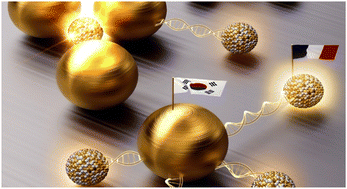
Chem. Commun., 2023,59, 2352-2380
https://doi.org/10.1039/D2CC06178C
Progress in the design of portable colorimetric chemical sensing devices
Developement of portable colorimetric devices for detection of heavy metals, anions, biomolecules, pesticides, drugs, and other substances is vital across clinical, environmental, and food safety domains.

Nanoscale, 2023,15, 19016-19038
https://doi.org/10.1039/D3NR03803C
Uncovering thermally activated purple-to-blue luminescence in Co-modified MgAl-layered double hydroxide
Co-modified nano-sandrose layered double hydroxide containing 15 mol% Co shows thermally-activated luminescence in the purple-to-blue visible-light region at room temperature.
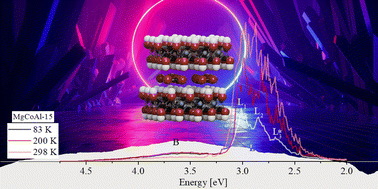
Nanoscale, 2024,16, 6449-6454
https://doi.org/10.1039/D3NR05205B
Tailoring fluorescent ZIF-8 nanostructures through calix[4]pyrrole modification: tunable size and enhanced organic micropollutant removal capacity
A size-controllable fluorescent ZIF-8 structure is synthesized through modification with a versatile supramolecule, bis-carboxylate functional calix[4]pyrrole. Upon modification, the micropollutant removal properties of ZIF-8 were adjustable.
![Graphical abstract: Tailoring fluorescent ZIF-8 nanostructures through calix[4]pyrrole modification: tunable size and enhanced organic micropollutant removal capacity](/en/Image/Get?imageInfo.ImageType=GA&imageInfo.ImageIdentifier.ManuscriptID=D3CC05934K&imageInfo.ImageIdentifier.Year=2024)
Chem. Commun., 2024,60, 866-869
https://doi.org/10.1039/D3CC05934K
Poly(lactic acid) stereocomplex microspheres as thermally tolerant optical resonators
Thermally tolerant polymer optical resonators are fabricated from a stereocomplex of poly(L-lactic acid) and poly(D-lactic acid) through the oil-in-water miniemulsion method.

Nanoscale, 2023,15, 19062-19068
https://doi.org/10.1039/D3NR05318K
Mesoporous alloy chiral nanoparticles with high production yield and strong optical activities
Gold functions as an adhesion layer and a dopant in the host silver chiral nanoparticles (CNPs), leading to high production yield and strong optical activities of binary mesoporous CNPs generated by galvanic replacement reactions of the host.

Chem. Commun., 2023,59, 14551-14554
https://doi.org/10.1039/D3CC04354A
Two-dimensional lead-free silver-bismuth double perovskite nanobelts with intrinsic chirality via co-antisolvent modulation strategy
The implementation of co-antisolvent modulation provides a robust strategy for numerous high-quality 2D lead-free chiral perovskite nanomaterials for chiroptical devices.
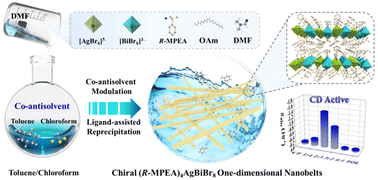
Chem. Commun., 2023,59, 14126-14129
https://doi.org/10.1039/D3CC04308H
Dual-signalled magneto-optical barcodes with lanthanide-based molecular cluster-aggregates
A proof-of-concept for magneto-optical barcodes is demonstrated for the first time.

Nanoscale, 2023,15, 18198-18202
https://doi.org/10.1039/D3NR03838F
Intra-cluster energy transfer editing in a dual-emitting system to tap into lifetime thermometry
The impact of composition control and energy transfer on luminescence thermometry was investigated in a TbIII/EuIII dual-emitting molecular cluster-aggregate, known as {Ln20}.

Chem. Commun., 2023,59, 13715-13718
https://doi.org/10.1039/D3CC03658H
Tracking the super resolved structure of mitochondria using red emissive carbon nanodots as a fluorescent biomarker
Observation of morphological changes in mitochondria under various conditions using red emissive carbon nano dots.
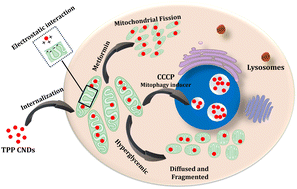
Chem. Commun., 2023,59, 13454-13457
https://doi.org/10.1039/D3CC03390B
Plasmon enabled Claisen rearrangement with sunlight
The use of a thermodynamically closed reactor prevented the interference of hot-charge carriers in the plasmonic-heat driven Claisen rearrangement, which is conventionally performed with electrical-heating at 250 °C.
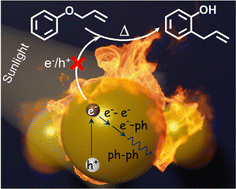
Chem. Commun., 2023,59, 13293-13296
https://doi.org/10.1039/D3CC04278B
Ligand-mediated electron transport channels enhance photocatalytic activity of plasmonic nanoparticles
We demonstrate that some organic ligands can provide electron transport channels that facilitate hot electron extraction from a gold nanostructure leading to a huge enhancement in the rate of photocatalytic hydrogen evolution reaction.
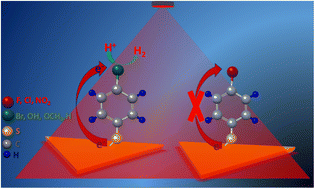
Nanoscale, 2023,15, 16552-16560
https://doi.org/10.1039/D3NR02829A
Time gated Fourier transform spectroscopy with burst excitation for time-resolved spectral maps from the nano- to millisecond range
We demonstrate burst-mode Time Gated Fourier Transform Spectroscopy (bmTG-FTS), a technique for simultaneously capturing and disentangling emission signals from short- (ns) and long-lived (μs–ms) states.

Chem. Commun., 2023,59, 12625-12628
https://doi.org/10.1039/D3CC03961G
Interfacial dipole engineering in all-inorganic perovskite solar cells
Different functional groups on 7-azaindole (7-AI) alter its passivation ability and dipole moment. Finally, 7-AI-OCH3 proves to be highly effective in passivating defects and optimizing energy level alignment.
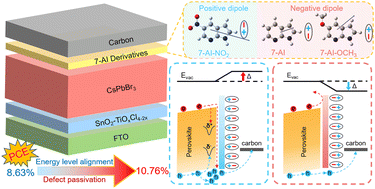
Chem. Commun., 2023,59, 12112-12115
https://doi.org/10.1039/D3CC03615D
Broadband red emission from one-dimensional hexamethonium lead bromide perovskitoid
A 1D (HM)Pb2Br6 based on hexamethonium has been developed for broadband red emission with a PLQY of 6.24%. Mechanistic investigations reveal that the red emission derives from the self-localized Pb23+, Pb3+ and Br2− species.
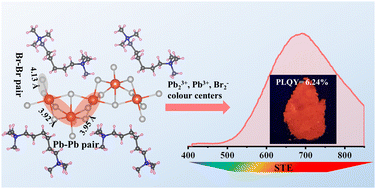
Chem. Commun., 2023,59, 11795-11798
https://doi.org/10.1039/D3CC03477A
Enhanced electrochemiluminescence imaging of single cell membrane proteins based on Co3O4 nanozyme catalysis
The development of enhanced strategies with excellent biocompatibility is critical for electrochemiluminescence (ECL) imaging of single cells.

Chem. Commun., 2023,59, 11736-11739
https://doi.org/10.1039/D3CC03484D
Donor–acceptor complex formation by social self-sorting of polycyclic aromatic hydrocarbons and perylene bisimides
Perylene bisimides equipped with bulky imide substituents self-assemble into orthogonally stacked dimers or bind up to two aromatic guests. These complexes were confirmed by single crystal X-ray analysis and their optical properties were elucidated.
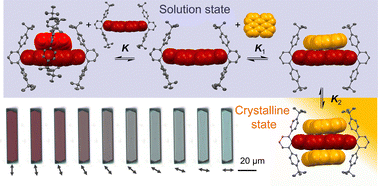
Chem. Commun., 2023,59, 11656-11659
https://doi.org/10.1039/D3CC03704E
Nanoporous YVO4 as a luminescent host for probing molecular encapsulation
A reverse microemulsion route enabled to probe the interfacial crystallisation of luminescent nanoporous YVO4 and to encapsulate dye molecules in the nanoparticle cavities.
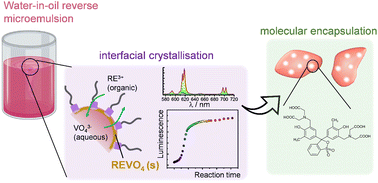
Chem. Commun., 2023,59, 11393-11396
https://doi.org/10.1039/D3CC03501H
Stable deep-blue FAPbBr3 quantum dots facilitated by amorphous metal halide matrices
Matrix structure is employed to synthesize stable deep blue FAPbBr3 quantum dot solid films exhibiting good structural and optical stability even after 245 day storage.
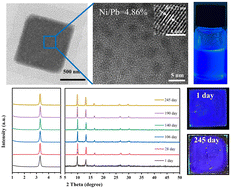
Chem. Commun., 2023,59, 11137-11140
https://doi.org/10.1039/D3CC03415A
Heat, pH, and salt: synthesis strategies to favor formation of near-infrared emissive DNA-stabilized silver nanoclusters
Synthesis yield of NIR-emissive DNA-stabilized silver nanoclusters is significantly enhanced by temperatures of 20 to 40 °C and basic pH.
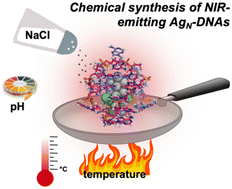
Chem. Commun., 2023,59, 10488-10491
https://doi.org/10.1039/D3CC02896H
Photonic enhancement in photoluminescent metal halide perovskite–photonic crystal bead hybrids
Photonic crystal-perovskite nanocrystal hybrid beads exhibit Purcell enhancement and increased quantum yields of photoluminescence. The photonic crystal matrix is key for modulating the optoelectronic properties of the incorporated nanocrystals.
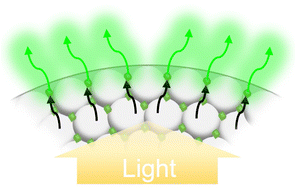
Chem. Commun., 2023,59, 10380-10383
https://doi.org/10.1039/D3CC02962J
Hybrid polymer dot-magnetic nanoparticle based immunoassay for dual-mode multiplexed detection of two mycotoxins
We designed polymer dot-magnetic nanoparticle nanohybrids for signal enhancement in a test strip platform.
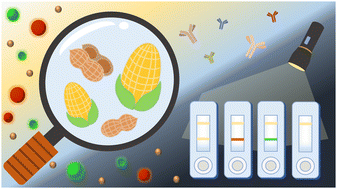
Chem. Commun., 2023,59, 9968-9971
https://doi.org/10.1039/D3CC02586A
Detection of SO2 using a chemically stable Ni(II)-MOF
The MOF-type Ni2(dobpdc) shows a high chemical stability towards SO2, high capacity for SO2 capture at low pressure (4.3 mmol g−1 at 298 K and up to 0.05 bar), and exceptional SO2 detection properties.
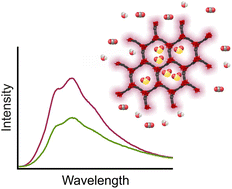
Nanoscale, 2023,15, 12471-12475
https://doi.org/10.1039/D3NR02936K
Crystal photonics foundry: geometrical shaping of molecular single crystals into next generation optical cavities
FIB milling of perylene and coumarin-135 microcrystals provides dimensionally- and geometrically-precise photonic resonators, paving a way for the industrial-scale production of organic photonic modules and devices.

Nanoscale, 2023,15, 12220-12226
https://doi.org/10.1039/D3NR02229C
“Turn-on” and pinhole-free ultrathin core–shell Au@SiO2 nanoparticle-based metal-enhanced fluorescent (MEF) chemodosimeter for Hg2+
We constructed a distinct ‘‘turn-on’’ Au@SiO2 nanostructure for a metal-enhanced fluorescence system. The metal-enhanced fluorescence chemosensor shows high sensitivity and selectivity toward Hg2+ with a detection limit of 5 × 10−11 mol L−1.

Nanoscale Adv., 2024,6, 2319-2327
https://doi.org/10.1039/D3NA00746D
Size-tunable silicon nanoparticles synthesized in solution via a redox reaction
A new liquid-phase redox synthesis to form silicon nanoparticles allows the solvent used during synthesis to determine particle size and fluorescent properties.
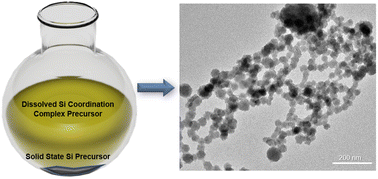
Nanoscale, 2024,16, 7958-7964
https://doi.org/10.1039/D3NR05793C
An electrografted monolayer of polyaniline as a tuneable platform for a glucose biosensor
Vertically Aligned Conducting Polymers: The article emphasizes the fabrication of an electrografted vertically oriented polyaniline and its application in a highly sensitive electrochemical glucose enzymatic biosensor utilizing this monolayer.

Nanoscale, 2024,16, 4647-4655
https://doi.org/10.1039/D3NR03680D
MXene-antenna electrode with collective multipole resonances
The work explores multipolar excitations in and utilization of nanostructured transition metal carbides and nitrides (MXene) layers in designing a photodetector electrode that exhibits enhanced response through hot-electron generation.
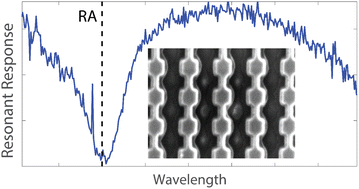
Nanoscale, 2024,16, 4656-4667
https://doi.org/10.1039/D3NR03828A
Direct laser induced writing of high precision gold nanosphere SERS patterns
Introducing a fast, reliable, and flexible “Direct Laser Writing” technology for printing precise and complex SERS-patters on different substrates of any desired structure with nanometer resolution for applications in sensor technology and optoelectronics.

Nanoscale Adv., 2024,6, 1213-1217
https://doi.org/10.1039/D3NA00855J
Surface modification effect on contrast agent efficiency for X-ray based spectral photon-counting scanner/luminescence imaging: from fundamental study to in vivo proof of concept
X-Ray imaging techniques are among the most widely used modalities in medical imaging and their constant evolution has led to the emergence of new technologies.

Nanoscale, 2024,16, 2931-2944
https://doi.org/10.1039/D3NR03710J
One-step synthesis of photoluminescent nanofluids by direct loading of reactively sputtered cubic ZrN nanoparticles into organic liquids
Sputtering of Zr in Ar/N2 produces stoichiometric, crystalline, conductive, and plasmonic ZrN nanoparticles that can be directly loaded into liquids.

Nanoscale, 2024,16, 2452-2465
https://doi.org/10.1039/D3NR03999D
Effect of hydrophilicity-imparting substituents on exciton delocalization in squaraine dye aggregates covalently templated to DNA Holliday junctions
Molecular aggregates exhibit collective sharing of electronic excitation energy known as exciton delocalization, that can be leveraged in applications such as quantum computing, optical information processing, and light harvesting.
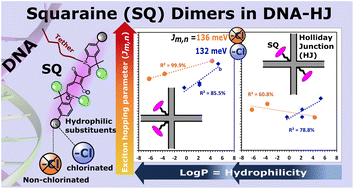
Nanoscale, 2024,16, 1206-1222
https://doi.org/10.1039/D3NR04499H
Direct synthesis of CsPbX3 perovskite nanocrystal assemblies
Perovskite nanocrystal assemblies have been directly synthesised via solvent and ligand induced enhancements of the attractive hydrophobic interaction.

Nanoscale, 2024,16, 614-623
https://doi.org/10.1039/D3NR04285E
Not all silicon quantum dots are equal: photostability of silicon quantum dots with and without a thick amorphous shell
The photostability of ∼5 nm diameter SiQDs with an amorphous shell was compared with that of over-etched SiQDs of equivalent dimensions that bore an a-Si shell of negligible thickness.
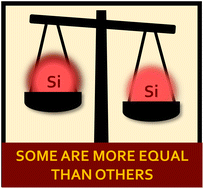
Nanoscale, 2024,16, 592-603
https://doi.org/10.1039/D3NR04478E
Aberrant photoelectric effect in the topological insulator/n-GaN heterojunction (Bi2Te3/n-GaN) under unpolarized illumination
Hint of the band gap modulation in the polycrystalline topological insulator Bi2Te3 film under unpolarized light and realization of photodetector with a typical range.

Nanoscale, 2024,16, 604-613
https://doi.org/10.1039/D3NR03360K
Tuning dipolar and multipolar resonances of chiral silicon nanostructures for control of near field superchirality
Superchiral resonances of silicon metasurfaces are controlled by manipulation of their excited electric and magnetic multipoles.
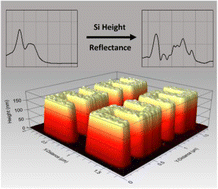
Nanoscale, 2024,16, 110-122
https://doi.org/10.1039/D3NR05285K
Optical single molecule characterisation of natural and synthetic polymers through nanopores
We developed a method based on image analysis to optically determine the molecular weight of both artificial and natural polymers translocating through nanopores.
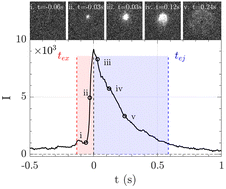
Nanoscale, 2024,16, 138-151
https://doi.org/10.1039/D3NR04915A
Generalised coupled-dipole model for core-satellite nanostructures
Comparison of the satellite absorbance spectra calculated with T-matrix and GCDM methods for the Au core surrounded by Ag satellites.
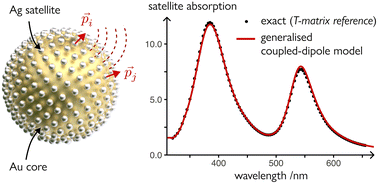
Nanoscale, 2023,15, 19767-19776
https://doi.org/10.1039/D3NR05238A
Synergistic or antagonistic effect of lanthanides on Rose Bengal photophysics in upconversion nanohybrids?
The photophysical behavior of rose bengal dramatically changes when functionalizing an upconversion nanoparticle due to its interaction with photoactive lanthanide cations of the matrix.
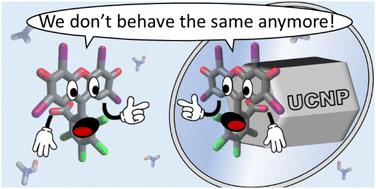
Nanoscale, 2023,15, 19792-19800
https://doi.org/10.1039/D3NR03774F
Core–multi-shell design: unlocking multimodal capabilities in lanthanide-based nanoparticles as upconverting, T2-weighted MRI and CT probes
Core/shell/shell nanoparticle design with a controlled inner NaGdF4 layer between the upconverting Er/Yb-doped NaGdF4 core and the magnetic NaDyF4 shell suppressed Dy3+-induced emission loss, while simultaneously enhancing MRI T2 and CT performance.
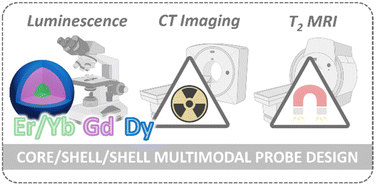
Nanoscale, 2023,15, 19546-19556
https://doi.org/10.1039/D3NR05380F
Influence of photothermal and plasma-mediated nano-processes on fluence thresholds for ultrafast laser-induced cavitation around gold nanoparticles
This work builds on an in-depth evaluation of cavitation bubbles around gold nanoparticles upon ultrafast laser photoexcitation and the transition of photothermal to plasma-mediated cavitation, depending on particle properties and laser pulse width.

Nanoscale Adv., 2023,5, 6887-6896
https://doi.org/10.1039/D3NA00743J
Understanding Yb3+-sensitized photon avalanche in Pr3+ co-doped nanocrystals: modelling and optimization
Multicolor photon avalanche emission of Pr3+ doped NaYF4 nanocrystals under 852 nm excitation is enabled by co-doping sensitizer Yb3+ ions.

Nanoscale, 2023,15, 18613-18623
https://doi.org/10.1039/D3NR04409B
Ion-induced bias in Ag2S luminescent nanothermometers
Upon exploring the properties of a mixed dispersion of iron oxide nanoparticles and Ag2S luminescent nanocrystals, we discover a new source of bias in luminescence thermometry induced by the presence of metal ions in solution.
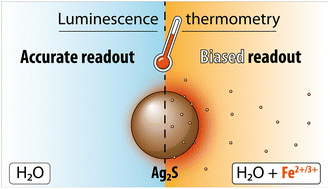
Nanoscale, 2023,15, 17956-17962
https://doi.org/10.1039/D3NR03728B
Supramolecular assembly of dendronized spiropyrans in aqueous solutions into nanospheres with photo- and thermo-responsive chiralities
Dendronized spiropyrans assemble in water to form nanospheres with remarkable supramolecular chirality, which can be reversibly tuned through isomerization of spiropyrans or thermal collapse of the dendritic OEGs.

Nanoscale, 2023,15, 18053-18067
https://doi.org/10.1039/D3NR03729K
Tuning nanoscale plasmon–exciton coupling via chemical interface damping
Here, we demonstrate how chemical interface damping (CID) influences the nanoscale plasmon–exciton coupling strength.

Nanoscale, 2023,15, 17879-17888
https://doi.org/10.1039/D3NR04013E
Facile microfluidic synthesis of monodispersed size-controllable quantum dot (QD) microbeads using custom developed QD photoresist
Simple and effective strategy for producing quantum dot microbeads (QD-MBs) with controllable sizes, which can be crucial in diverse fields such as biosensing, drug delivery, and imaging.
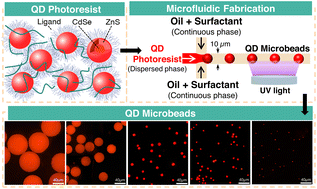
Nanoscale, 2023,15, 17473-17481
https://doi.org/10.1039/D3NR03544A
Thin-film conformal fluorescent SU8-phenylenediamine
On the surface and volume.
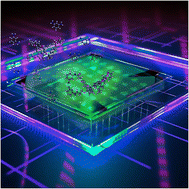
Nanoscale, 2023,15, 17544-17554
https://doi.org/10.1039/D3NR02744A
Engineering GaN/AuNC core–shell nanowire heterojunctions by gold nanoclusters with excitation-dependent behavior for enhancing the responsivity and stability of self-driven photodetectors
It is novel to demonstrate a self-driven ultraviolet-visible photodetector based on the gallium nitride/gold nanocluster (GaN/AuNC) core–shell nanowire heterojunctions fabricated by introducing the AuNCs onto the GaN NW surfaces.
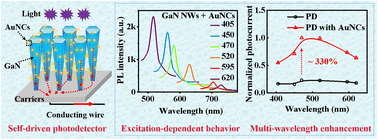
Nanoscale Adv., 2023,5, 6228-6237
https://doi.org/10.1039/D3NA00463E
Quantitative, precise and multi-wavelength evaluation of the light-to-heat conversion efficiency for nanoparticular photothermal agents with calibrated photoacoustic spectroscopy
Multi-wavelength light-to-heat conversion efficiency of dispersed nanoparticles is directly the ratio between the calibrated photoacoustic spectrum and the attenuation spectrum.
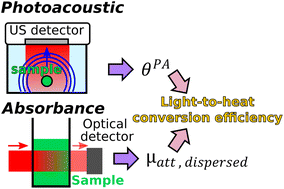
Nanoscale, 2023,15, 17085-17096
https://doi.org/10.1039/D3NR03727D
Improving the stability of photodoped metal oxide nanocrystals with electron donating graphene quantum dots
Functionalization of Sn-doped In2O3 NCs with specifically designed electron-donating graphene quantum dots (HBC–AOM) enhances the stability of photodoped electrons over prolonged UV light exposure.

Nanoscale, 2023,15, 17138-17146
https://doi.org/10.1039/D3NR03534D
Exceptional ultrafast nonlinear optical response of functionalized silicon nanosheets
This study reveals that the functionalization of silicon nanosheets with styrene and tBuMA leads to nanostructures with exceptional nonlinear optical response. These nanostructures could have potential applications in optoelectronics and photonics.

Nanoscale, 2023,15, 16636-16649
https://doi.org/10.1039/D3NR03497F
Impact of thermal annealing and laser treatment on the morphology and optical responses of mono- and bi-metallic plasmonic honeycomb lattice
This work investigates the refinement effect of thermal annealing or ns-pulsed laser treatment methods on the morphology and optical responses of mono- and bi-metallic plasmonic honeycomb lattice prepared by nanosphere lithography.

Nanoscale, 2023,15, 16626-16635
https://doi.org/10.1039/D3NR03522K
Three-dimensional building of anisotropic gold nanoparticles under confinement in submicron capsules
Encapsulated gold nanotriangles (AuNTs) were assembled into a three-dimensional structure inside a permeable silica nanocapsule under light illumination to generate multiple localized surface plasmon resonance modes with different energies.

Nanoscale Adv., 2023,5, 5780-5785
https://doi.org/10.1039/D3NA00683B
Ultrafast dynamics in plasmon–exciton core–shell systems: the role of heat
We introduce a concise model for the ultrafast dynamics of plasmon–exciton nanoparticles. Assuming that all modulations are caused by heat, we can nicely recreate the transient spectra.

Nanoscale, 2023,15, 16307-16313
https://doi.org/10.1039/D3NR02817H
Extraordinary optical transmittance generation on Si3N4 membranes
Optical properties of Si3N4 membranes are modified via patterning of holes to excite surface phonon polaritons and increase transmittance.

Nanoscale, 2023,15, 16002-16009
https://doi.org/10.1039/D3NR02834H
Predictable incorporation of nitrogen into carbon dots: insights from pinacol rearrangement and iminium ion cyclization
This study employed a rational design approach using glucosamine and ethylene glycol to synthesize N-doped carbon dots, overcoming the challenge of understanding N-incorporation chemistry and enabling precise control over N-incorporated structures.

Nanoscale Adv., 2023,5, 5613-5626
https://doi.org/10.1039/D3NA00550J
Atomic/molecular layer deposition of europium–organic thin films on nanoplasmonic structures towards FRET-based applications
We present a novel atomic/molecular layer deposition (ALD/MLD) process for europium–organic thin films based on Eu(thd)3 and 2-hydroxyquinoline-4-carboxylic acid (HQA) precursors.

Nanoscale, 2023,15, 15865-15870
https://doi.org/10.1039/D3NR04094A
Femtosecond-laser-assisted high-aspect-ratio nanolithography in lithium niobate
A femtosecond-laser-assisted lithium niobate nanolithography technique is developed. The etching rate is enhanced to 2 μm h−1. The nanohole size reaches ∼100 nm and the aspect ratio is above 40 : 1.
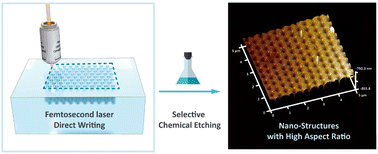
Nanoscale, 2023,15, 15298-15303
https://doi.org/10.1039/D3NR03750A
Boosting the efficiency of transient photoluminescence microscopy using cylindrical lenses
Transient Photoluminescence Microscopy (TPLM) with cylindrical lenses allows for an improved visualization of carrier transport in semiconductor materials.

Nanoscale, 2023,15, 14831-14836
https://doi.org/10.1039/D3NR03587E
Surface and optical properties of phase-pure silver iodobismuthate nanocrystals
Phase-pure and highly crystalline AgBiI4 NCs are synthesized by hot-injection synthesis route. The iodine-rich surface of the NCs enable their impressive long-term environmental and thermal stabilities. This study shines light on the surface-electronic structure relationship for AgBiI4 NCs.
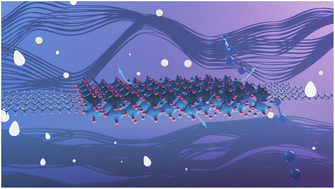
Nanoscale, 2023,15, 14764-14773
https://doi.org/10.1039/D3NR02742B
Luminescent hexagonal microtubes prepared through water-induced self-assembly of a polymorphic organoboron compound: formation mechanism and waveguide behaviour
Strong blue fluorescent HNBI-B, its polymorphic behavior and water-induced self-assembly (WISA) into nanodiscoids and fluorescent hexagonal microtubes with efficient waveguide behavior are described.
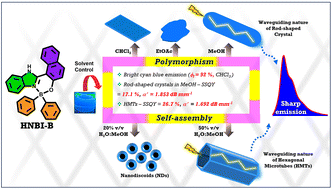
Nanoscale, 2023,15, 14380-14387
https://doi.org/10.1039/D3NR02903D
Hybrid multifunctionalized mesostructured stellate silica nanoparticles loaded with β-diketonate Tb3+/Eu3+ complexes as efficient ratiometric emissive thermometers working in water
The synthesis and properties of efficient ratiometric nanothermometers based on mesoporous stellate nanoparticles functionalized with an acetylacetonate derivative and loaded with β-diketonate-Tb3+/Eu3+ complexes working in water, PBS or cells.

Nanoscale, 2023,15, 14409-14422
https://doi.org/10.1039/D3NR01851B
Lateral surface passivation of CdSe nanoplatelets through crown management
Radiative and nonradiative recombination centers are located on the lateral surface of the CdSe nanoplatelets.
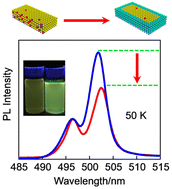
Nanoscale, 2023,15, 14140-14145
https://doi.org/10.1039/D3NR03133K
Achieving photostability in dye-sensitized upconverting nanoparticles and their use in Fenton type photocatalysis
The poor photostability of dye-sensitized upconverting nanoparticles limits their applicability. By covalently encapsulating modified IR820 in a silica shell, the accessibility of oxygen to interact and cause degradation is completely avoided.

Nanoscale, 2023,15, 13583-13594
https://doi.org/10.1039/D3NR02845C
Anisotropy and thermal properties in GeTe semiconductor by Raman analysis
Low-symmetric GeTe semiconductor has excellent optical and thermal properties, but few studies are available on their in-plane optical anisotropic nature that is crucial for their applications in optoelectronic and thermoelectric devices.
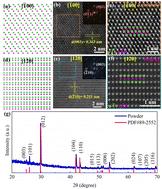
Nanoscale, 2023,15, 13297-13303
https://doi.org/10.1039/D3NR02678G
Exploring the intra-4f and the bright white light upconversion emissions of Gd2O3:Yb3+,Er3+-based materials for thermometry
Upconversion broadband white light emission driven by low-power near-infrared lasers has been reported for many materials, but the mechanisms and effects related to this phenomenon remain unclear.

Nanoscale, 2023,15, 9993-10003
https://doi.org/10.1039/D3NR01764H
About this collection
Advanced optical nanomaterials are the building block to innovative technologies that have the potential to address societal challenges from energy to health. Optical nanomaterials offer solutions to more efficient energy harvesting and energy conversion technologies, to enhanced data storage and fast and secure telecommunication, or to more efficient and personalized biomedical approaches, to name just a few examples. To achieve the goal of real-life applications, better understanding of known processes and the discovery of new fundamental phenomena is key.
This cross-journal collection in ChemComm and Nanoscale, guest edited by Professor Arindam Chowdhury (IIT Bombay, India), Dr Alison Funston (Monash University, Australia), Professor Eva Hemmer (University of Ottawa, Canada) and Professor Jonathan Veinot (University of Alberta, Canada), features research reporting new processes, phenomena, applications, and fundamental science in optical nanomaterials.